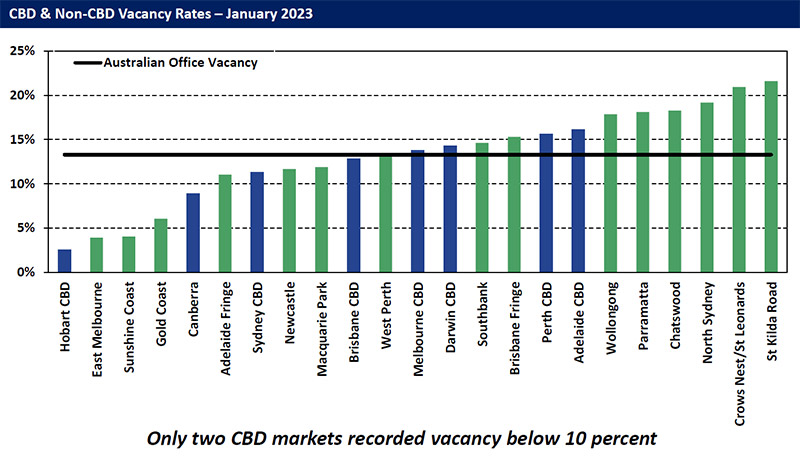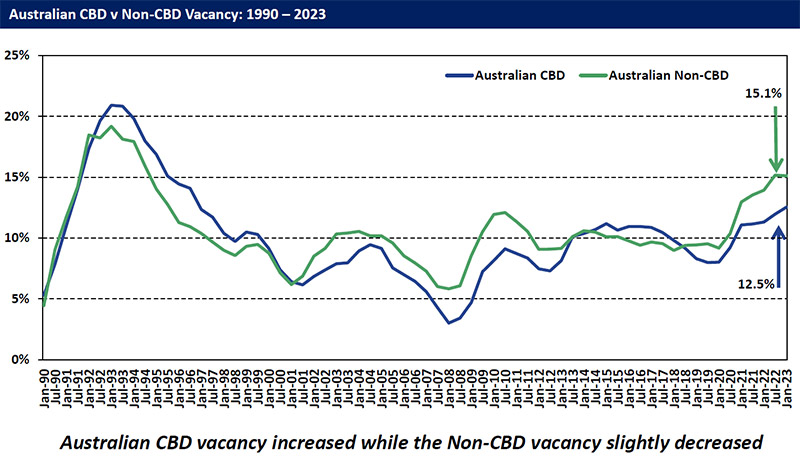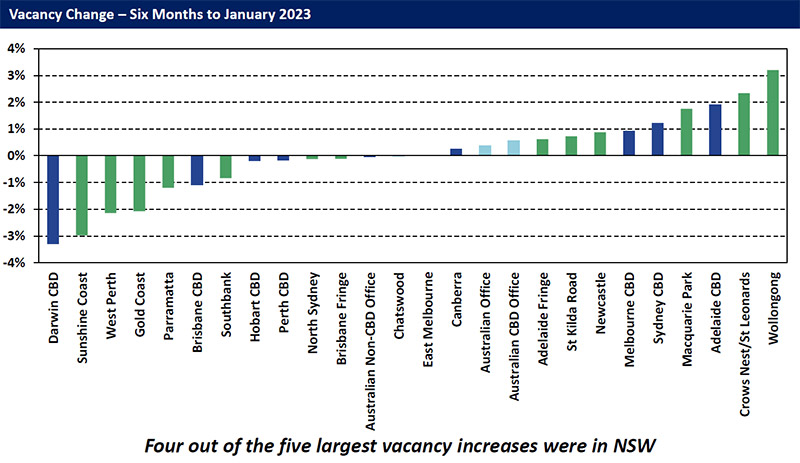Office workers still not convinced about returning to their desks
The national office vacancy rate continues to climb, with the lure of the desk and cubicle still struggling to compete with the newfound freedoms of working from home.
The trend towards more empty offices that took hold in 2020 is continuing, with national office vacancy rates edging up again over the past six months.
The office vacancy rate now as of January 2023 now sits at 13.3 per cent, the highest rate since the mid-1990s and an increase of 0.4 per cent since July.
Four out of the five largest vacancy increases were in NSW, while office space availability tightened the most in Darwin, Sunshine Coast, West Perth and Gold Coast, according to the Property Council’s Office Market Report.
Perth has the highest rate of office occupancy at 80 per cent, while Sydney and Melbourne CBDs recorded their greatest occupancy post pandemic at 59 per cent and 57 per cent respectively. Tourism markets have not disappointed with average Australian occupancy for November 2022 high at 72.8 per cent after recording 44.8 per cent the prior year.
Another report on the state of commercial property markets in Australia found that investor demand is falling due to rising interest rates.
The newly released Royal Institution of Chartered Surveyors (RICS) Global Commercial Property Monitor said the commercial property market in Australia remained subdued, with tenant demand for office space is now slightly negative (-1 per cent net balance) and the demand for retail premises suppressed (-14 per cent net balance).
“Respondents cited that the market is being impacted by a sharp deterioration in credit conditions, caused by rising central bank rates,” the report noted.
“As such, currently more than 80 per cent of respondents to the survey in Australia view the commercial property market to be in a downturn or at the bottom of the cycle.”

Source: Property Council of Australia, Office Market Report - January 2023
Tim Molchanoff, Cushman & Wakefield’s Head of Office Leasing, Australia and New Zealand said from a national perspective, the flight to quality story remains a hot topic for the national leasing market.
“As was visible in 2022, office leasing activity across Australia in 2023 will be marked by transitions; shifts in ways of working, the economic cycle, and financial markets will all play a role in shaping tenant demand,” he said.
“The big-ticket objectives last year of getting people back to the office and attracting talent in a tight labour market aren’t abating.
“This is now leading occupiers, particularly smaller organisations, to pursue quality space, albeit in some cases, smaller space, which will help rents stabilise or move higher in 2023.
“We anticipate national office vacancy will sit between 12-14 per cent this year.”
Suburban offices
According to Jenny Folley, founder and CEO of @WORKSPACES, the pandemic has changed the way people work and as a result, workers want to be near home and be able to work out of offices that offer all the perks of a city office without the travel, cost and congestion.
This has triggered a boom in demand for suburban-based offices and more flexible out-of-home working environments such as private offices and coworking spaces, she said.
“Demand for micro-offices is surging as businesses across the country walk away from large offices to set up multiple smaller offices in the suburbs to meet the needs of employees.
“Employees want to work close to home and businesses are responding by giving up their large CBD-based offices and setting up multiple micro-offices in the suburbs.
“This is the only way the businesses can retain or attract staff. Staff don't want to travel into the city anymore. They want to work close to home.”
Office vacancy in non-CBD markets decreased slightly in the past six months as CBD vacancies continued their upwards march.

Source: Property Council of Australia, Office Market Report - January 2023
Around the country, the big improvers among CBDs were Darwin, Perth and Brisbane, which decreased vacancies by between 3.2 and 1.2 per cent.
Melbourne and Sydney vacancies rates up by about 1 per cent and Adelaide by just under 2 per cent.
Sandra Brewer, Property Council WA Executive Director, said while the improvement seems modest, the results in the Office Market Report are a strong indicator of underlying market resilience as an additional 13,788sqm space was added to the market in the reporting period.
“Both the Perth and West Perth markets are showing strong signs of improvement,” Ms Brewer said.
“Even with businesses adapting to hybrid workforce arrangements, what we are seeing is that the role of the office remains central to the employee experience.
“Contrary to many predictions, flexibility does not appear to be reducing demand for space. Sublease vacancy rates – often an indicator of businesses downsizing space requirements - remain low at 0.6 per cent, well below the historical average of 1.7 per cent, indicating businesses are using their whole of office space.
“We are seeing a shift from desk dominant office space, with tenants increasingly requiring more room for a superior office experience, with additions such as wellness rooms, collaboration spaces, lounges for socialising and sophisticated coffee machines,” she said.
Sydney, Melbourne office prospects
Cushman & Wakefield Melbourne and Sydney specialists explained why those markets were softer and what how their prospects for 2023 shaped up.
Antonia Foweraker, National Director and NSW Head of Office Leasing, said, “Quality remains front of mind for businesses to encourage their staff to return to the office together with talent attraction and retention remaining the key issues.
“Overarching economic uncertainty has led tenants to delay leasing decisions, which has placed some upwards pressure on vacancy.
“A limited supply of newly constructed office space in 2023 should provide a short-term cushion for the market.”

Source: Property Council of Australia, Office Market Report - January 2023
Giuseppe Ruberto, Head of North Shore and Metropolitan Office Leasing said the flight to quality remains the clear trend for tenants in his domain as companies adjust to a hybrid working model.
“This has led to a tightening in North Sydney’s Prime market, which is likely to persist until the new developments at Victoria Cross and Blue Street are completed.
“Beyond this, any new construction will likely be limited by the ability to secure pre-commitments from tenants.
“Further afield in the Metro markets, Parramatta and Macquarie Park are likely to feel some pain particularly in the B-grade stock as tenants in these markets upgrade to newly completed A-grade space.
“This segment of the market is experiencing significant upwards pressure in vacancy and incentives.”
In Melbourne, there was a divergence in the market.
Chas Keogh, National Director, Joint Head of Department, Office Leasing Victoria, said vacancy is reducing and rents are still performing well in good quality buildings that are well located and owned by landlords willing to invest in them.
“The vacancy rate is forcing landlords to be proactive in what they do to ensure longevity during tough market conditions, and those not proactive will and are suffering off the back of the market’s higher vacancy rate, which will be recorded anywhere between 13-16 per cent in the Melbourne CBD.”





















